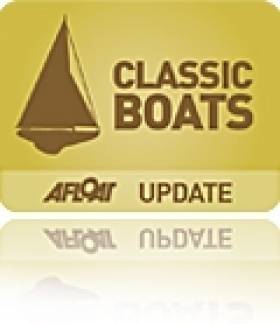Displaying items by tag: Daunt Lightship rescue
#FamousLifeboat – Former Ballycotton RNLB lifeboat, Mary Stanford, made famous for a daring rescue of the Daunt Rock lightship crew in 1936, was hoisted out from Grand Canal Dock basin yesterday and headed to her old east Cork homeport, writes Jehan Ashmore.
The Barnett-class lifeboat was loaded onto a truck to start the final stage of her homecoming following a campaign to save the vessel from further neglect having languished for many years.
Upon her return to Munster, The Save The Mary Stanford Project committee intend to have the boat raised on a plinth near the entrance to the Ballycotton Cliff walk and they are seeking donations to assist in her restoration that may involve the boat covered during this period.
Her restoration would allow those to appreciate the lifeboat's career and particularly the role she played during Daunt Rock lightship rescue that took place 78 years ago. The 60-hour ordeal would became the first and only lifeboat in RNLI history to have been awarded a gold medal for gallantry, that is for the boat herself, as well as her crew who were recognised for their bravery.
In recent years she was moored alongside Naom Eanna which been given a month's reprieve, otherwise she is to be scrapped by Waterways Ireland.
Famous Ballycotton Lifeboat Saved Leaves Fate of Naom Éanna Open to Dáil Questions?
#FamousLifeboat – Former Ballycotton RNLB lifeboat, Mary Stanford, arguably the most famous vessel to serve the institution, is due to return 'home', following years of neglect in Dublin's Grand Canal Dock, leaving the fate of Naom Éanna much to be desired, writes Jehan Ashmore.
On Wednesday, Naom Éanna, the former Galway-Aran Islands ferry built by Liffey Dockyard in 1958 for the CIE operated service, was moved by Waterways Ireland on foot of safety concerns should the veteran vessel spring a leak and sink in the basin. Such a situation potentially poses health, safety risks not to mention a navigation obstacle that could hinder notably the Viking Splash Tours amphibious excursion craft entering the basin.
As for the Mary Stanford, her fate is finally secured after two decades in attempting to restore her, following the establishment of a committee that began in October 2013 which has successfully raised funds in acquiring the 51ft Barnett-class lifeboat.
In mid-March she is due to be transported by road to Ballycotton on Cork's southern coastline, where she made history in rescuing the crew of the Daunt lightship in 1936. The 60-hour ordeal that took place on 11 February, 78 years ago, would became the first and only lifeboat in RNLI history to have been awarded a gold medal for gallantry, that is for the boat herself, as well as her crew who were recognised for their bravery.
The Gold medal was awarded to Coxwain Patrick Sliney, a grandfather of Colm Sliney who is involved in the campaign to bring her home. The silver and bronze medals were also presented to the rest of the crew at a ceremony held in London and notably attended by Duke of Kent, who would later abdicate as King Edward VII. A photograph of the event depicts the Duke chatting to some of the lifeboat crew as published in the Cork Examiner of the time, see the Facebook page for Save the Mary Stanford.
On the return of Mary Stanford to Munster, the boat will be raised on a plinth near the entrance to the Ballycotton Cliff walk and may need to be covered during her restoration. The cruiser-stern boat has mahogany decks surrounding her superstructure constructed on a double-diagonal planked hull.
During her career between 1930 and 1959, she was called out on 41 'shouts' resulting in the saving of 122 lives. In order to carry out this second stage of the restoration project, further fundraising is required and the committee have also set up a website to the lifeboat that saved so many lives!
At one stage, the lifeboat beame a pilot cutter for Limerick Harbour Commissioners before eventually ending up in the Grand Canal Basin, from where until recently she was moored alongside Naom Éanna. Noting, this is how her name is spelt (as to distinct to Naomh with a 'h'), and port of registry, Gallim, using Gaelic traditional script which can be barely be seen when viewed from the basin as the stern of the vessel remains exposed in the graving dock.






























































